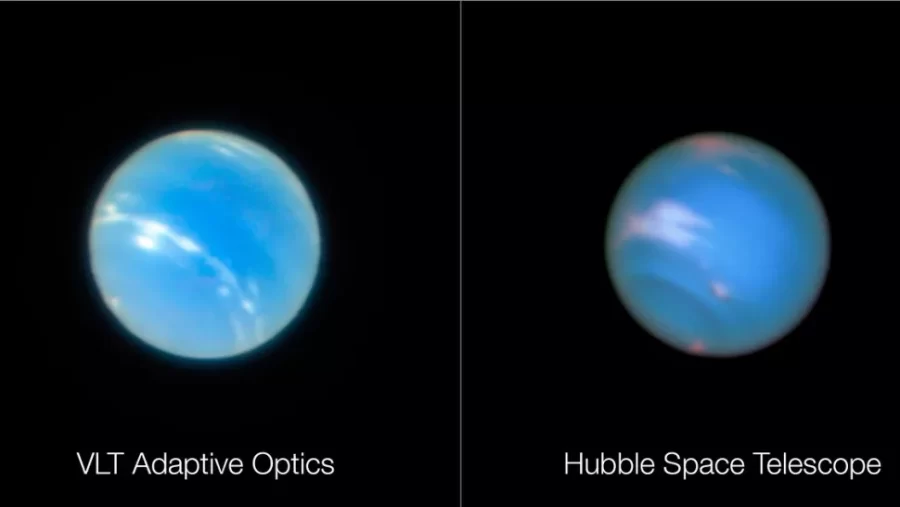Neptune Is Cooling Down
ESO/P. Weilbacher (AIP)/NASA, ESA, and M.H. Wong and J. Tollefson (UC Berkeley)
An image of Neptune taken by the Very Large Telescope of the European Southern Observatory (right), and one by the Hubble Space Telescope (left).
April 14, 2022
Among all the other planets in the Solar System, Neptune is the furthest away by far. In fact, Neptune is orbiting 30 times farther away from the Sun than Earth, with one year lasting 165 Earth years. Also known as an ice giant, Neptune is composed mainly of elements heavier than hydrogen and helium, such as oxygen, carbon, nitrogen, and sulfur. Thus, the seasonal change lasts more than 40 Earth years- each.
Currently, the southern hemisphere of Neptune is in its summer phase, which started around the year 2005. However, a new study published in The Planetary Science Journal by ESO scientists recently observed its average global temperatures plunge down by an astonishing 46.4 degrees Fahrenheit (8 degrees Celsius). Dr Michael Roman, Postdoctoral Research Associate at the University of Leicester said: “This change was unexpected. Since we have been observing Neptune during its early southern summer, we would expect temperatures to be slowly growing warmer, not colder.”
An international team of researchers, including scientists from Leicester and NASA’s Jet Propulsion Laboratory (JPL), combined all existing thermal infrared images of Neptune gathered from multiple observatories over almost two decades. With this data, researchers were able to reveal a more overall complete picture of Neptune’s trend in temperatures than ever before. Surprisingly, these collective datasets show a decline in Neptune’s thermal brightness since reliable thermal imaging began in 2003.
However, on the opposite side at Neptune’s south pole, the data reveal a different and surprisingly dramatic change. A combination of observations from Gemini North in 2019 and Subaru in 2020 reveal that Neptune’s polar stratosphere, the second lowest layer of the planet’s atmosphere, warmed by roughly 20 degrees Fahrenheit (11 degrees Celsius) between 2018 and 2020, reversing the previous globally averaged cooling trend. Such polar warming has never been observed on Neptune before.
The cause of these unexpected stratospheric temperature changes is currently unknown, and the results challenge scientists’ understanding of Neptune’s atmospheric variability. Though, it should be noted that observations of the planet have only been possible for the past few decades, so scientists know very little about the natural passing of the seasons. “Our data cover less than half of a Neptune season,” Glenn Orton, Senior Research Scientist at JPL and co-author on the study said in the statement. “So no one was expecting to see large and rapid changes.”
“The temperature variations may be related to seasonal changes in Neptune’s atmospheric chemistry, which can alter how effectively the atmosphere cools,” Dr. Roman said. “But random variability in weather patterns or even a response to the 11-year solar activity cycle may also have an effect.” This cycle has been previously suggested to affect Neptune’s visible brightness, and a new study reveals a possible, but tentative, correlation between the solar activity, stratospheric temperatures, and the number of bright clouds seen on Neptune.
Follow-up observations of both cloud patterns and temperature are needed to further assess any real connection in the near future, but scientists hope that future observations will reveal more about the mystery that is Neptune.


